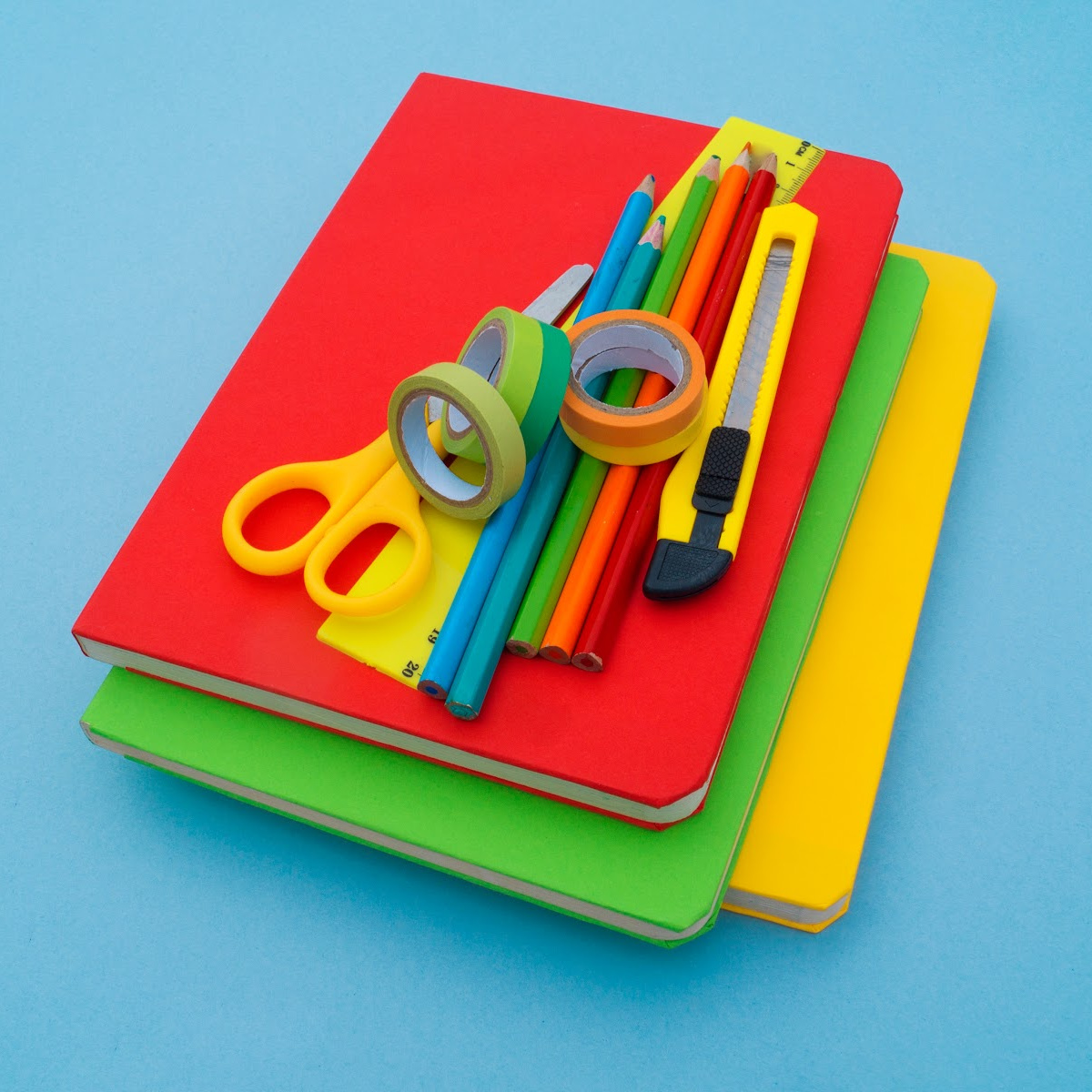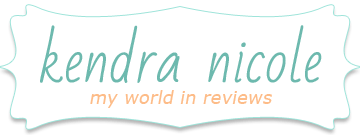Summer is still underway for many, but in our home it’s just about time to head back to school. We will be starting our school year next Monday, which is an earlier start than most but great for us because it allows for a few short breaks this fall while still getting us to our goal of completing half of our year’s curriculum before taking a six-week semester break between Thanksgiving and New Year’s.
I still feel like a newbie homeschooler, so it’s hard to get my head around the fact that this is our sixth year of officially schooling at home (longer if you consider the “unschooling” we did with Charleston during his preschool years). Every year has looked a little different, with each year presenting new changes and challenges, but there has not been a single time when I have second guessed our decision to homeschool. I know that homeschooling is NOT for every family; for us, it is the perfect fit. I love the family time that it allows—that I get to spend my days with my children, and that they get so much time with each other—and the opportunities it provides for shaping my kids’ spiritual, academic, and social education. Homeschooling is challenging and imperfect and an ongoing exercise in trusting the Lord’s guidance AND I remain incredibly grateful that we have the privilege and ability to do school in our own unconventional way.
In some ways, a lot about this coming year is a continuation of what we did last year when Charleston was in 4th grade and the twins were doing pre-K. But this year’s coursework is more rigorous now that the kids are older (especially the twins, whom I now consider “full time students,” not just the “part time” students that they were for pre-K). An added wrinkle is that I am officially teaching two grade levels, but Kali and Sully are academically at very different places; I will be doing Kinder curriculum with both to keep things simple, but will need to supplement Sully’s work since he is working at more of a first-grade level at this point. On top of all of the teaching, we are going to be navigating school with a toddler, as opposed to an infant, which will be easier in some ways and harder in others. Keeping Nico occupied during our school time has been and will likely continue to be one of the harder parts of our homeschool days.
One HUGE change for this school year is that our family has joined a Classical Conversations community. This is our first time doing a true co-op rather than a one-day extracurricular drop-off program! We are brand new to the CC world so I don’t have a lot to say about the program just yet, and don’t totally know all of what our involvement will entail. What I do know is that our whole family will attend a weekly community day (which will provide the homeschool community we’ve NEEDED), and that there will be at-home assignments that we are adding onto our current work load (which may end up being too much, requiring some adjustments). As its name suggest, CC follows the Classical model of homeschooling, which is something we’ve only dabbled with in the past. I tend to blend several different approaches in our homeschool (Classical, Charlotte Mason, and Traditional) and don’t intend to go “full Classical”—at least not yet. As you’ll see, this continued blending is reflected in our curriculum plans for the year.
It’s become a tradition for me to share our annual school plans here on the blog. This is partly selfish, since I find it so helpful to put my plans to paper before launching into the year. But I’ve heard from many of you saying that you benefit from these posts as well—either because you are also homeschoolers and appreciate the recommendations and inspiration, or because you aren’t a homeschooling family and are intrigued by the details of a family who does school at home. Whatever brings you here, I’m happy to share! I’ll begin with an overview of the curriculum and other materials we are using this year, as well as a list of organizational tools and additional resources that go into making our homeschool a success. I will then give a play-by-play of what our typical school day will look like.
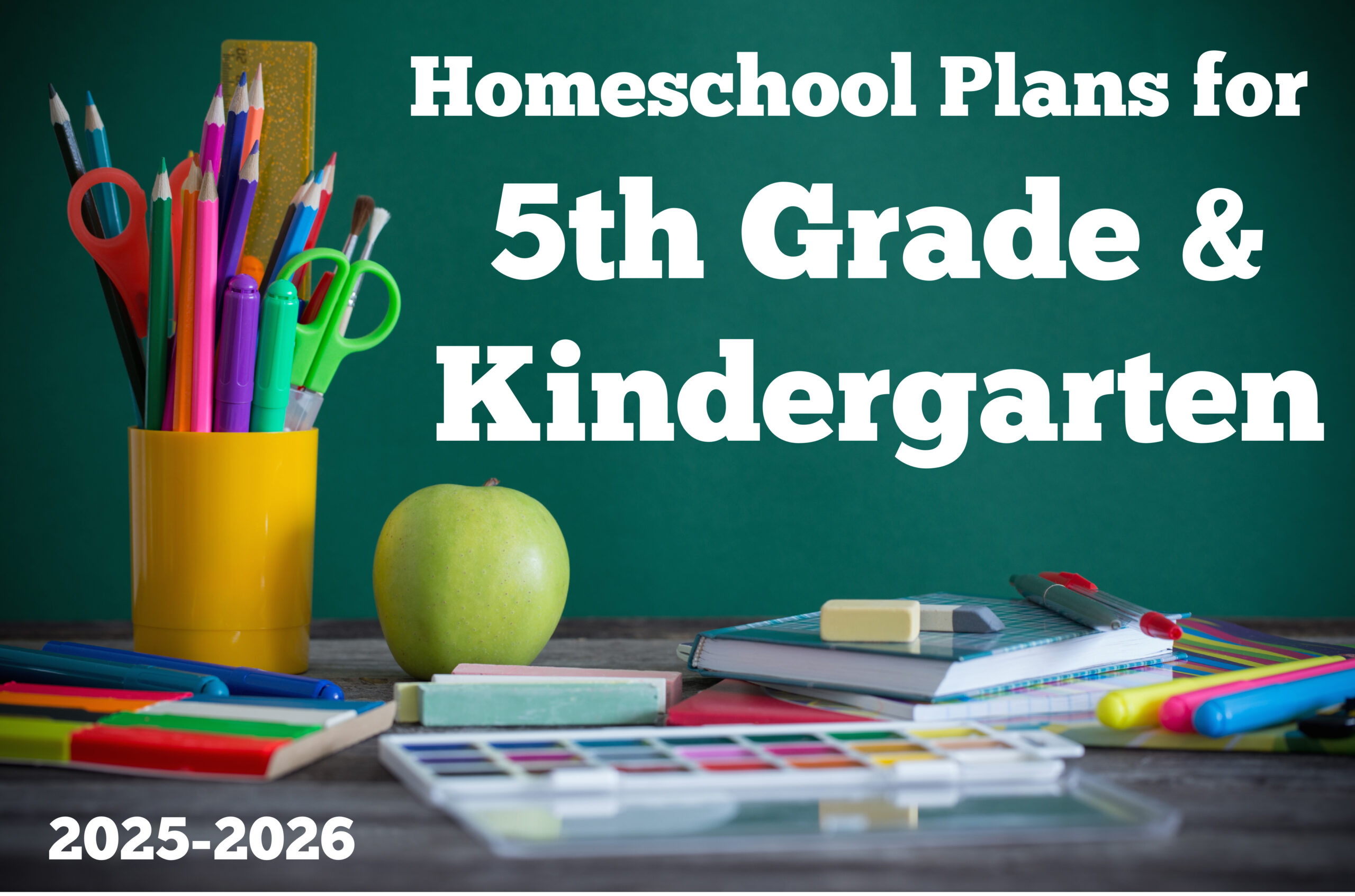
THE CURRICULUM
WHOLE FAMILY:
Classical Conversations Foundations: Foundations English Language Since we are new to the CC world, I do not know all that this curriculum will entail and will follow our CC leader’s guidance in incorporating it into our other daily schoolwork. I do know that the Foundations curriculum consists mostly of memory work that we will do during our family time together at the start of each school day.
Scripture Memory: This year we will begin memorizing Jesus’ Sermon on the Mount (Matthew 5-7), with hopes of memorizing chapter 5 by the end of this school year by memorizing one or two verses each week. On Mondays I will introduce that week’s verses, which will serve as their handwriting practice/copy work for that day (I’m using this website to create my own copy-and-trace worksheets—cursive for Charleston and printing for the twins). The kids will come up with motions to correspond to the verse, and we will practice it throughout the week.
History: The Mystery of History Volume III—The Renaissance, Reformation, and Growth of Nations It took us several years to settle on a History curriculum I love and could recommend, but we’ve finally found it! This is our second year with this student-friendly curriculum that takes a chronological, Bible-based approach to world history, covering all of history (Creation through present day) over four courses (Ancient History, Medieval History, Renaissance History, and Modern History). We will be picking up where we left off after completing Medieval History last year. We will read aloud and discuss the daily readings as a family, and we may do some of the supplemental activities, coloring pages, and crafts recommended in the course companion guide. Charleston will do the pretests and quizzes that correlate with each week’s readings. As I read, the kids will have the option of coloring in their Renaissance coloring books that do not come with the curriculum but align with the time period we are studying.
Independent Reading: The kids are given free choice in their independent reading selections, though I do provide some guidance and have veto power if necessary. The twins look at magazines or picture books, while Charleston reads chapter books. I participate too, and it’s my favorite part of our school day.
PE: This year, the twins will join Charleston in the weekly sports program for homeschoolers that we’ve participated in since Charleston was in Kinder. They are all excited to do this together!
Science, Geography, Latin, Music, & Presentation: These are all covered during the Foundations portion of our CC community day on Tuesdays.
Read-Alouds: I’ve pre-selected all of our family read-alouds for the school year; we will be reading Understood Betsy, Johnny Tremain, Cheaper by the Dozen, Number the Stars, Island of the Blue Dolphins, Bridge to Terabithia, Holes, Black Beauty, The Witch of Blackbird Pond, Little House on the Prairie and A Christmas Carol (illustrated ediciton). We don’t do much work with these beyond reading aloud and discussing, with some occasional coordinating activities thrown in. After finishing each book, we work together as a family to write a book review (the ones I feature in my Quick Lit reviews!) and Charleston adds the book to his Reading Journal.
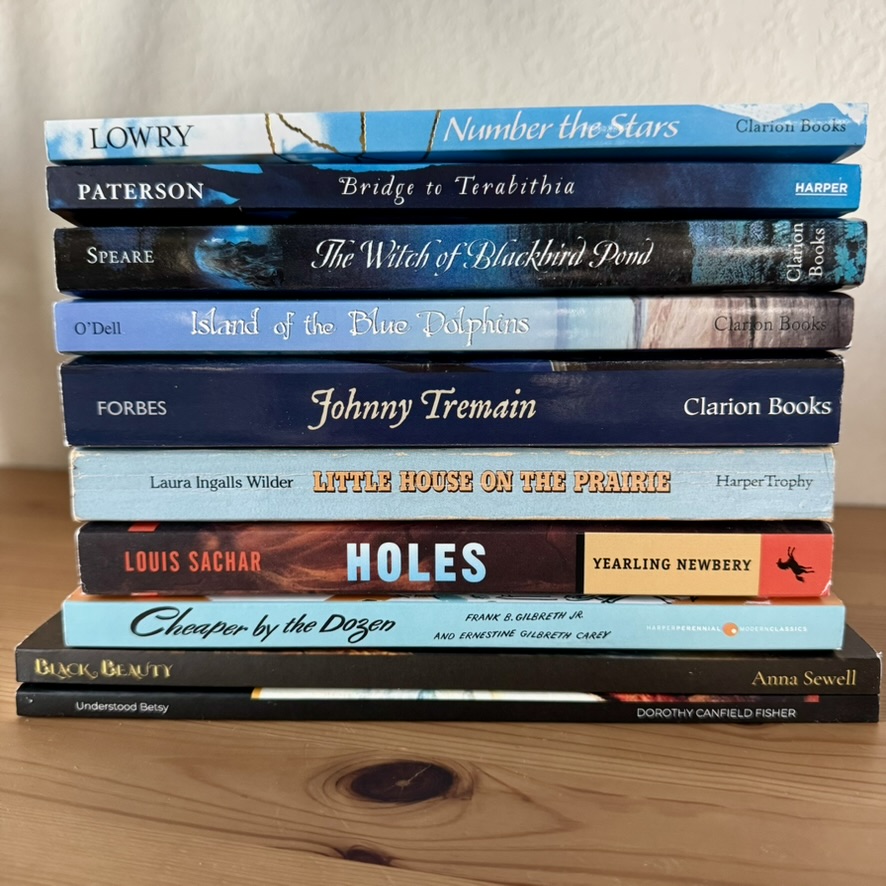
CHARLESTON (5TH GRADE):
Language Arts: The Good and the Beautiful Level 5 Language Arts Course Set (includes a Course Book, Book Set, & Grammar & Geography Cards) I love everything about the curriculum from The Good and the Beautiful, which takes a faith-based Christian approach and combines aspects of Charlotte Mason and classical learning styles. It is affordable, attractive, academically rigorous without feeilng overwhelming, and entirely open-and-go. This course covers reading, literature, writing, spelling, grammar, usage, punctuation, vocabulary, geography, and art appreciation and instruction, and the Level 5 course is largely student-led with some small portions of each lesson that are done with the parent.
Additional Language Arts: Classical Conversations Essentials We are new to this program, which teaches the foundational principles of language structure and analysis. We will be following the guidance of our CC community as we work to integrate the CC curriculum into our other Language Arts learning.
Writing: IEW Medieval History-Based Writing and IEW Teaching Writing Structure and Style Workbook This writing curriculum is also new for us and we will be following the guidance of our CC guide, who will be doing the writing instruction and giving weekly writing assignments.
Math: The Good and the Beautiful Math 5 Course Set (includes the Course Book and Mental Math Map Mysteries) Charleston completed the first half of this curriculum last spring and will finish up Level 5 in December. We plan to move on to Level 6 mid-year. This curriculum is almost entirely student-led, with daily video lessons as well as the option for parent-led follow-up lessons to solidify challenging concepts.
Handwriting: The Good and the Beautiful Handwriting, Level 5 Charleston completed the first half of this workbook—which focuses on cementing cursive letter formation, with some refinement of printed handwriting—last year. The course incorporates images, artwork, poetry, Bible verses, and quotes into the writing practice, as well as drawing activities that make the practice of handwriting more enjoyable. We will finish this in December and plan to move on to the Level 6 Handwriting Workbook mid-year.
Biblical World View : Foundation World View—Comparative World View I have loved all of the curriculum from Foundation World View (our family has now done nearly every course), and while it is a small portion of our homeschool, it is the cornerstone of our learning in the way that it lays the groundwork for spiritual discipleship in our home. This course, which is designed for kids 8 and up, equips kids with a Biblical worldview and exposes them to the basic beliefs of competing worldviews. The video-based lessons are enhanced by downloadable activity sheets. The course is designed to be done along with the parent, as the lessons are quite rigorous and explore many concepts that need to be discussed between parent and child.
Piano: Simply Piano Charleston has been doing piano lessons with this app for a few years and has made good progress in just ten minutes of practice each day.
Typing: Typesy Kids Elementary Keyboarding This fun, fast-paced curriculum integrates video teaching, games, and exercises to teach correct touch typing. Charleston began this program over the summer and will continue to do one or two lessons each day throughout the school year as he works towards keyboarding mastery.
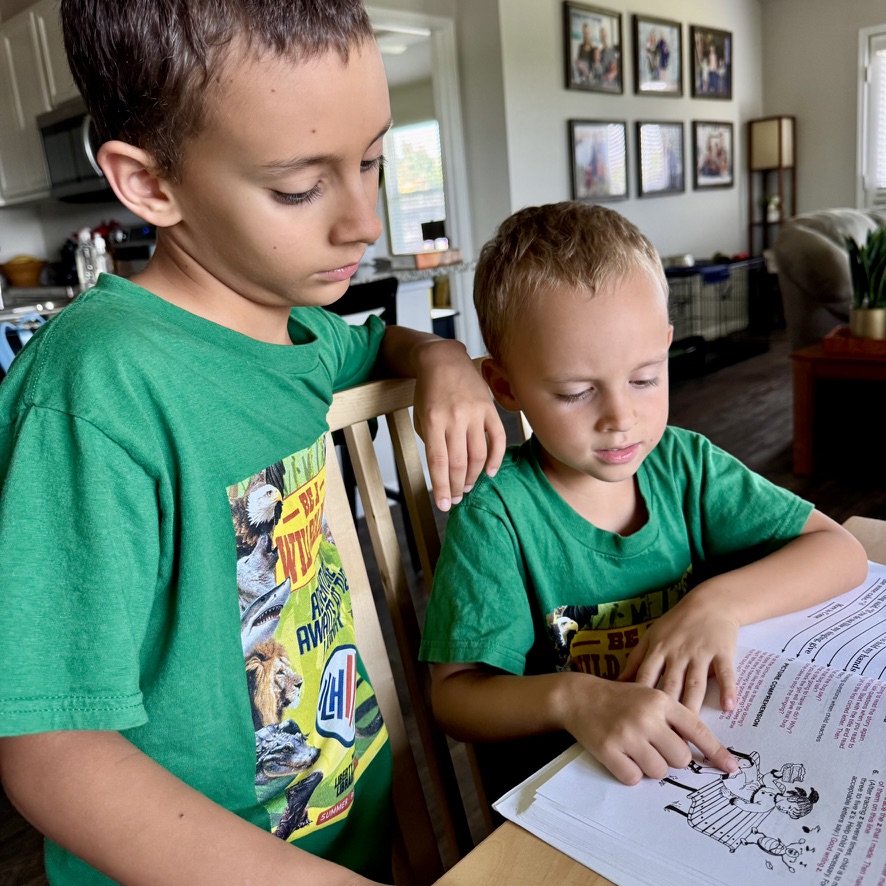
KALINDA & SULLIVAN (KINDER):
Language Arts: The Good and the Beautiful Level K Language Arts Course Set (includes Course Book [I purchased an additional course book so Kali and Sully would each have their own], Reading Booster Cards, and and Reading Booster Books Set) This beautiful, open-and-go course teaches reading, phonics, writing, spelling, literature, grammar and punctuation, geography, and art through faith-based lessons that incorporate strong moral values.
Reading: Teach Your Child to Read in 100 Easy Lessons This book may not be beautiful or flashy, but it absolutely delivers on its promise to get kids reading quickly and effectively. The phonics-based lessons are straightforward and frustration-free for both parent and child. Charleston successfully learned to read with this book when he was in Kinder; I began using it with Sully earlier this year when he expressed an interest in starting to “read real books,” and now he has just a few more lessons to go and is fluently reading multi-paragraph stories. Kali is about halfway through the lessons and also having good success, despite a slower start. Once I finish this book with Sully (and eventually with Kali), we will move on to having them read aloud to me from books on the guide’s recommended reading list.
Math: The Good and the Beautiful Math K Course Set (includes Course Book [I purchased an additional course book so Kali and Sully would each have their own]) and Math K Box) We didn’t discover The Good and the Beautiful until Charleston was in second grade, so this will be my first time through the Kinder Math curriculum; I am excited to be introducing math to Kali and Sully through this lovely, approachable curriculum (SO MUCH BETTER than the Singapore Math we used with Charleston for Kinder). The short, parent-led lessons utilize games and manipulatives (included in the Math K Box) to teach basic math concepts.
Biblical World View: Foundation World View—Attributes of God This course helps kids ages 4-8 understand the character and nature of God. The video-based lessons are designed to be done alongside a parent and use simple teaching and games to teach complex truths. We will watch the videos as a family and work together to complete the accompanying activity sheets.
Handwriting: The Good and the Beautiful Level K Handwriting Workbook This workbook, which focuses on correct print formation of letters and numbers, introduces 2-3 letters at a time, with short words and sentences near the end. Drawing activities are incorporated in many lessons to keep the course enjoyable and increase fine motor skills.
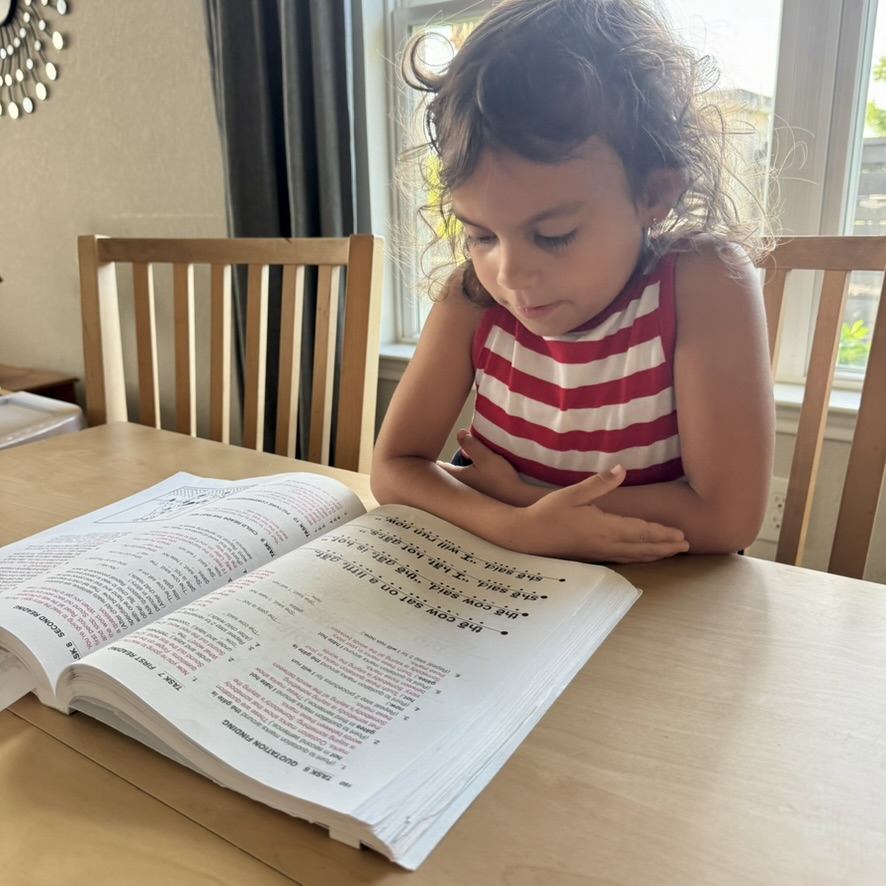
ORGANIZATIONAL TOOLS
All of our school resources are kept in a large bookcase in our playroom. Charleston, Sullivan, and Kalinda are each responsible for their own pencil box, and each child has a basket that holds his or her folders, course materials, a blank sketchbook for drawing during read-aloud time or while waiting for their siblings to finish work, and a binder with divider tabs for each of our subjects.
I have my own basket that holds my student manuals and the materials we use as a whole family, such as our history book, read-alouds, and use this simple planner that I use to keep track of our lessons.
ADDITIONAL RESOURCES
+ Beyond our Biblical World View curriculum and Scripture memory, we don’t include Bible reading in our school day. This takes place before bedtime, when the twins and I read and discuss a story from a children’s Bible (we’re currently working our way through the One Year Bible Storybook). Charleston and Luke do their own nightly Bible study and are more than halfway through their one-year chronological reading of the Bible along with The Bible Recap; each night they read that day’s selections in Charleston’s study Bible and discuss the corresponding devotional from The Bible Recap book.
+ While it is not really part of our schooling, Charleston’s participation in Trail Life (weekly meetings, periodic activities, service opportunities, and monthly camping trips) has been a huge part of his education. This year Sully will also be joining Trail Life, and Kali and I will be joining American Heritage Girls.
+ Also pivotal for Charleston (and for me this year as a group leader) is his involvement with our church’s mid-week Discipleship Program for 4th and 5th graders.
+ We could never survive without our library cards! We visit the library almost weekly to pick up picture books for the twins, chapter books and playaways for Charleston, and DVDs and board games for the whole family.
+ I’ve said it before, and it’s still true: our Adventures in Odyssey Club Membership continues to be the best $10 we spend every month. The kids have learned SO MUCH through the hundreds of audio dramas available on the app, and Charleston enjoys the various other features including activities, devotionals, and a weekly comic strip, plus monthly subscriptions to Focus on the Family’s magazinse for kids (Clubhouse for Charleston and Clubhouse Jr. for the twins).
+ Our family discovered The Tuttle Twins a few months ago and have become huge fans of this series that takes a fun, story-based approach to teaching history, government, and economics. We have—and are learning a great deal from—all of the books, from the graphic novels and adorable board books (toddler friendly but filled with concepts that are instructive for our whole family!) to the topical picture books, Choose Your Consequence series, and guidebooks that teach important topics like illogical fallacies, entrepreneurship, critical thinking, and (Charleston’s favorite) true conspiracies.
+ We’ve had this Melissa and Doug magnet calendar for years; after putting it away for a season, we’ve brought it back out to teach calendar skills to Kali and Sully. We use it alongside this fun wall calendar that is helping them gain more calendar awareness.
+ Kali and Sully have learned so much geography from the LeapFrog Adventure Globe that has become their favorite quiet time activity.
+ Of my three big kids, Kali has been our most reluctant reader, but this LeapReader system has gone a long way in helping her become more enthusiastic about reading.
+ A few more must-have resource books on our shelf include this elementary dictionary, this thesaurus, and this student atlas.

THE GAME PLAN
I am sharing our ideal schedule based on what has worked for us in the past, but this is flexible and will likely change a great deal as the school year progresses.
MONDAY, WEDNESDAY, & FRIDAY:
6:30-6:40 ~ Gather in the school room and begin our day with our version of Circle Time which includes prayer time, a recitation of the Pledge of Allegiance and Apostle’s Creed, and updates to our calendar.
6:40-6:50 ~ Practice our weekly Bible Verse. The verse is introduced on Monday, and the kids come up with accompanying hand motions. We practice the verse Monday-Thursday, and on Friday the kids recite the verse for a video that is sent to family members.
6:50-7:10 ~ Spend time on our CC Memory Work. If weather allows, we will do this on a brief walk around the neighborhood or in the backyard on the swings or trampoline.
7:10-7:40 ~ Move to the dining table for the remainder of our school morning. The kids work on their Bible verse copywork (Monday) or Penmanship workbooks (Wednesday-Friday) while I read from our current Read-Aloud novel. After reading, we briefly discuss what we have read, tying in real-world applications and literary skills (foreshadowing, character development, plot analysis, etc.).
7:40-8:30 ~ Charleston moves to his room to watch his math lesson and do the corresponding independent work while I do Language Arts and Math lessons with the twins. They work on any follow-up independent assignments while I make breakfast.
8:30-9:00 ~ Breakfast time!
9:00-10:15 ~ I work individually with each of the kids. With Charleston, this includes the parent/child portions of his Math, Language Arts, Writing, and CC Essentials assignments. With Kali and Sully, this includes reading booster cards (part of their Language Arts) and having them read aloud to me, either from the Teach Your Child to Read… book or, when that is completed, from phonics-based picture books.
10:30-12:30 ~ If time allows, we go to the YMCA for me to workout while the three littles go to childwatch and Charleston works on his independent Language, Writing, and CC assignments.
1:00-1:30 ~ Home for lunch! We usually listen to Adventures in Odyssey while we eat.
1:30-2:00 ~ Complete our weekly Foundation World View lesson (Monday with the twins and Wednesday with Charleston).
2:00-2:30 ~ Read our daily History lesson; the kids color in their Renaissance coloring books while I read and afterwards we discuss the reading and possibly do a corresponding worksheet, craft, or activity.
2:30-3:00 ~ Gather in the living room with our books for DEAR (Drop Everything And Read) time.
3:00-4:30 ~ The twins go to their room for quiet play time while Charleston does his piano lesson, typing lesson, and any remaining independent work.
TUESDAY:
We are with our CC community group from 9:00-3:00 on Tuesdays and do not do any additional homeschool work on this day.
THURSDAY:
Schedule is a repeat of our M/W/F schedule in the morning, with our usual afternoon lessons moved up so that we can have lunch by noon and get the kids to Sports Day at 100. They are home by 4:30 and complete chores and any unfinished independent work then.
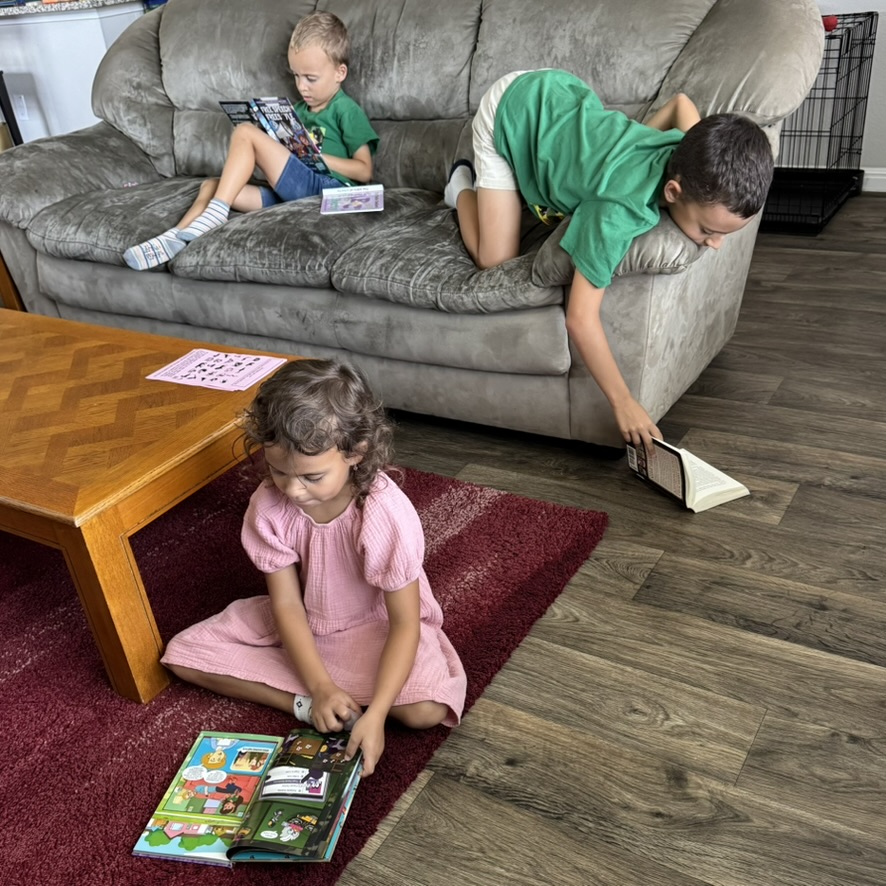
I hope that you have found this post helpful or, at the very least, interesting. If you have any questions, please do not hesitate to send them my way: drop a note in the Comments and I will do my best to answer. If you are a fellow homeschooler, I’d love to hear from you: what does YOUR homeschool day look like? What curriculum do you use? Any must-have tips or ideas to suggest? I’m all ears!
